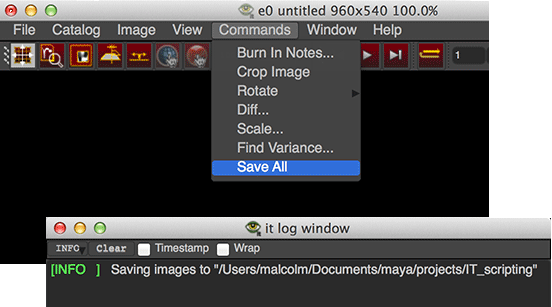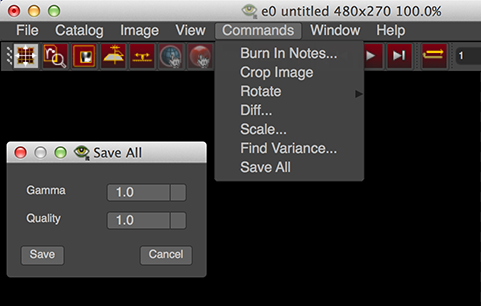|
# Modified: Nov 16 2014 - checks if images have an existing a numeric extension.
# Modified: Nov 29 2014 - checks if images have a "v#-" prefix ex. "v22-".
import it, time, os
from it.It3Command import It3Command
from PythonQt.QtGui import QDialogButtonBox
from PythonQt.QtGui import QHBoxLayout
from PythonQt.QtGui import QVBoxLayout
from PythonQt.QtGui import QComboBox
class SaveAll(It3Command):
def __init__(self):
self.m_menuPath = 'Commands/Save All...'
self.m_dialog = None
self.m_stdButtons = QDialogButtonBox.Apply|QDialogButtonBox.Cancel
def Invoke(self):
if self.m_dialog == None:
self.m_dialog = self.makeUI()
self.m_dialog.show()
self.m_dialog.raise_()
self.m_dialog.activateWindow()
def doit(self):
gamma = float(self.m_gamma.currentText)
quality = float(self.m_quality.currentText) * 100.0
host_dir = self.saveAll(gamma, quality)
it.app.Info('Images saved to "%s"' % host_dir)
it.app.RaiseLogWindow()
def makeUI(self):
dlg = self.CreateDialog('Save All')
contents = dlg.findChild(QVBoxLayout, 'contents')
layout = QHBoxLayout()
contents.addLayout(layout)
label_gamma = QLabel("Gamma ")
layout.addWidget(label_gamma)
self.m_gamma = QComboBox()
self.m_gamma.addItems(['1.0','1.8','2.0','2.2'])
self.m_gamma.setCurrentIndex(3)
layout.addWidget(self.m_gamma)
layout = QHBoxLayout()
contents.addLayout(layout)
label_quality = QLabel("Quality ")
layout.addWidget(label_quality)
self.m_quality = QComboBox()
self.m_quality.addItems(['0.5','0.75','1.0'])
self.m_quality.setCurrentIndex(2)
layout.addWidget(self.m_quality)
bbox = dlg.findChild(QDialogButtonBox, 'bbox')
doItButton = bbox.button(QDialogButtonBox.Apply)
doItButton.setText('Save All')
doItButton.connect('clicked()', self.doit)
return dlg
def saveAll(self, gamma=1.0, quality=100):
localtime = time.asctime( time.localtime(time.time()) )
localtime = localtime.replace(' ', '_')
localtime = localtime.replace(':', '_')
outname = 'catalog_%s' % localtime
cwdpath = os.getcwd()
if len(cwdpath) < 3:
cwdpath = os.environ['HOME']
if len(cwdpath) < 3:
it.app.Error('Unable to determine the current working directory.')
it.app.Error('Unable to save the images.')
it.app.RaiseLogWindow()
return
out_dirpath = os.path.join(cwdpath,outname)
if not os.path.exists(out_dirpath):
os.mkdir(out_dirpath)
aovDict = {}
cat = it.app.GetCurrentCatalog()
img_counter = 1
for i in range (0, cat.GetChildCount()):
element = cat.GetChild(i)
imgname = it.os.path.basename( element.GetFilename() )
if imgname == '_preview':
continue
# When "Export Catalog" has been used and the .itcat is re-opened
# the images will appear as "v1-somename.tif", "v2-somename.tif". Here
# we strip the "v#-" prefix - Nov 29 2014.
tokens = imgname.rpartition('-')
imgname = tokens[2]
# Add a padded numeric extension,
# but only if it does not end with digits - Nov 16 2014
tokens = imgname.rpartition('.')
if len(tokens[1]) > 0 and self.isaNumber(tokens[2]):
imgname = tokens[0] + ('.%04d' % img_counter) + '.jpg'
else:
imgname = imgname + ('.%04d' % img_counter) + '.jpg'
out_imgpath = os.path.join(out_dirpath, imgname)
self.saveImage(element, out_imgpath, gamma, quality)
img_counter += 1
# Save any AOV's
for j in range (0, element.GetChildCount()):
aov = element.GetChild(j)
aovname = it.os.path.basename( aov.GetFilename() )
# Remove the extension
aovname = os.path.splitext(aovname)[0]
# Maintain unique counters for each AOV
aov_counter = 1
if aovDict.has_key(aovname):
aov_counter = aovDict[aovname]
aov_counter += 1;
aovDict[aovname] = aov_counter
# Strip a"v#-" prefix
tokens = aovname.rpartition('-')
aovname = tokens[2]
# Add a padded numeric extension, again, only if the name doesn't
# end with digits.
tokens = aovname.rpartition('.')
if len(tokens[1]) > 0 and self.isaNumber(tokens[2]):
aovname = tokens[0] + ('.%04d' % img_counter) + '.jpg'
else:
aovname = aovname + ('.%04d' % img_counter) + '.jpg'
#aovname = aovname + ('.%04d' % aov_counter) + '.jpg'
out_aovpath = os.path.join(out_dirpath, aovname)
self.saveImage(aov, out_aovpath, gamma, quality)
return cwdpath
def saveImage(self, element,path,gamma,quality):
image = element.GetImage()
image = image.Gamma(gamma);
image.SetMetaDataItem('JPEG_QUALITY', quality)
image.Save(path, ice.constants.FMT_JPEG)
def isaNumber(self, str):
try:
int(str)
return True
except ValueError:
return False
it.commands.append(SaveAll)
|

